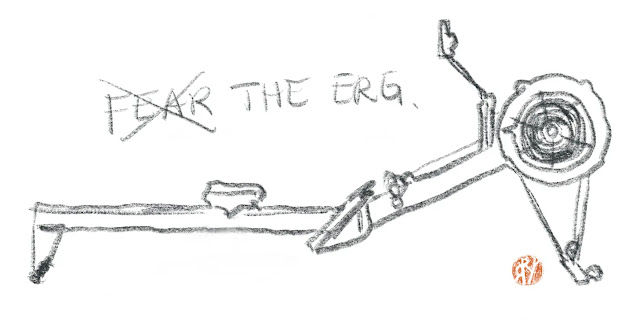Moving Rowing Forward: The Evolution of Onboard Data Measurement Systems
The development of the first Concept2 ergometer by the Dreissigacker Brothers in the early 1980s helped rowing make its first quantum leap in terms of affordable, objective data measurement systems. The erg was, and still is, the great equalizer—you can compare your split times, wattage, and power curves to the likes of Hamish Bond and Eric Murray in a real and meaningful way, whether you're sitting next to the Kiwi Pair at the Rowing New Zealand training facility, or in a boathouse on the Charles River.
 |
| Looking over the boat, IRAs 2013 (Photo: B. Kitch) |
Now, of course, there are a variety of quality options for indoor rowing machines. However, more and more, the rowing world has been pushing for that next step—bringing those objective measuring systems and tools on board while on the water.
An early method of quasi-objective measurement on the water, still widely used as a means of determining relative speed, is seat-racing, but, as we discussed in our feature article yesterday, that's not a particularly accurate approach.
In recent years, there have been several emerging products on the market. Perhaps the most widely adopted and easily added product to the existing setup is the Nielsen-Kellerman SpeedCoach, which measures boat-speed using an impeller wired to NK's Cox Box. Alternatives to these are the various levels of CoxMate (Australia) products. As for telemetry, BioRow is an onboard rowing biomechanics system that has been used in Europe (follow the link to read a write-up from a BioRow test by 2014 Henley Masters winner Tom Carter of Upper Thames Rowing Club).
An early method of quasi-objective measurement on the water, still widely used as a means of determining relative speed, is seat-racing, but, as we discussed in our feature article yesterday, that's not a particularly accurate approach.
In recent years, there have been several emerging products on the market. Perhaps the most widely adopted and easily added product to the existing setup is the Nielsen-Kellerman SpeedCoach, which measures boat-speed using an impeller wired to NK's Cox Box. Alternatives to these are the various levels of CoxMate (Australia) products. As for telemetry, BioRow is an onboard rowing biomechanics system that has been used in Europe (follow the link to read a write-up from a BioRow test by 2014 Henley Masters winner Tom Carter of Upper Thames Rowing Club).
Stateside, the SmartOar (which uses sensors embedded within the oar shaft to measure flexion and power application, with data from each stroke wirelessly transmitted to a portable display) hit the rowing market before the 2012 Olympics, allowing coaches to get perhaps the most accurate sense of both relative performance as well as synchronicity to date.
Currently, an Australian start-up called Oar Inspired is looking to develop a line of products (including wireless gates, and instrumented foot plates) that will further this trend toward more accurate, and affordable, onboard data accumulation. The project is running a Kickstarter campaign, and, at time of writing, has raised roughly $54,000 of a $70,000 goal. You can learn more about Oar Inspired via the video below:
In addition to the above, there are several smartphone applications that make use of the phone's GPS to provide splits and acceleration curves, offering still more insight in very a accessible way. Some of the best options out there are CrewNerd (a SpeedCoach alternative), and Rowing in Motion (accelerometer—see video below).
Currently, an Australian start-up called Oar Inspired is looking to develop a line of products (including wireless gates, and instrumented foot plates) that will further this trend toward more accurate, and affordable, onboard data accumulation. The project is running a Kickstarter campaign, and, at time of writing, has raised roughly $54,000 of a $70,000 goal. You can learn more about Oar Inspired via the video below:
In addition to the above, there are several smartphone applications that make use of the phone's GPS to provide splits and acceleration curves, offering still more insight in very a accessible way. Some of the best options out there are CrewNerd (a SpeedCoach alternative), and Rowing in Motion (accelerometer—see video below).
The above is by no means a comprehensive list—here are a few more recommendations, including price points and feature breakdowns, courtesy of Tom Carter, in the form of a Google spreadsheet.
Having just put together a piece for ROWING Magazine on the history and development of indoor rowing machines, the idea of accurate, objective data measurement is one that has been on my mind.
Having just put together a piece for ROWING Magazine on the history and development of indoor rowing machines, the idea of accurate, objective data measurement is one that has been on my mind.
While the rest of the world becomes increasingly aware of the sport based on indoor rowing becoming a popular fitness tool (just look at recent articles in Shape, Men's Journal, Harper's Bazaar, The New York Times, The Seattle Times, etc.), the rowing world will become increasingly interested in affordable onboard measurement/telemetry systems that can be integrated with indoor rowing machines, giving athletes and coaches a more complete view of training and development than ever before. So much for sandbagging.
-Bryan
-Bryan



